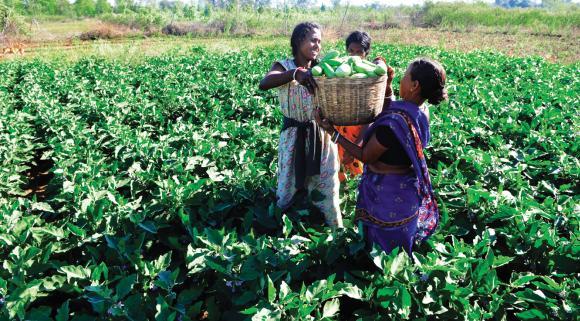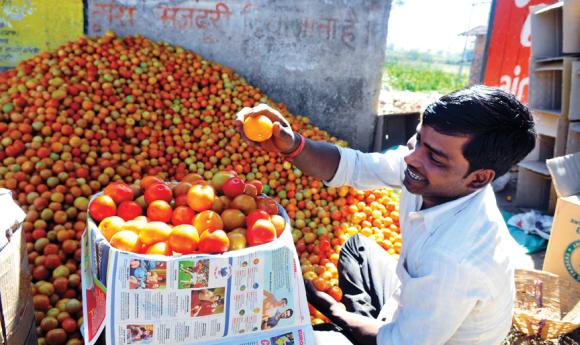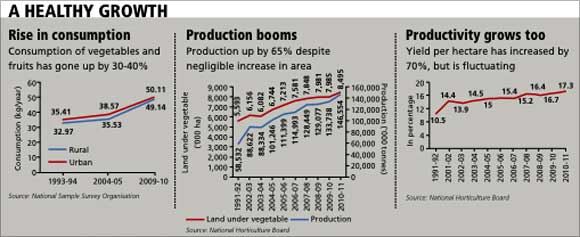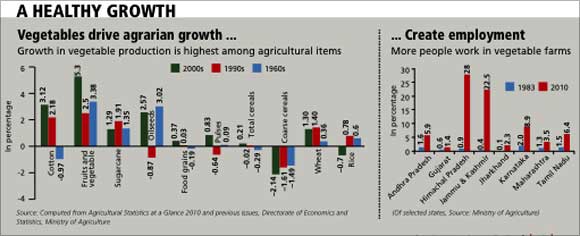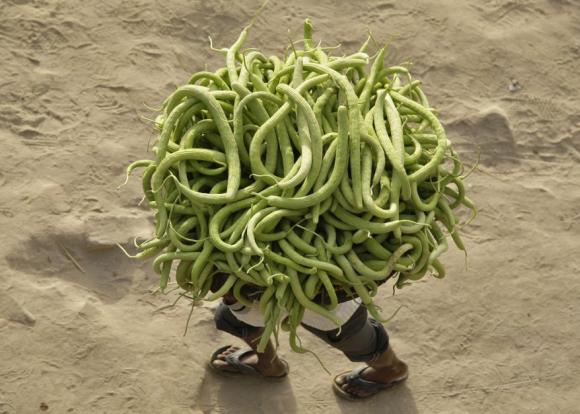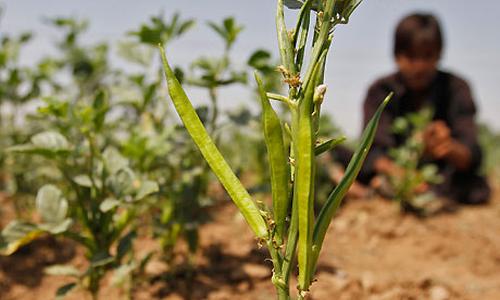 | « Back to article | Print this article |
How small farmers are revolutionising agriculture
Already reeling from recurring droughts and declining productivity of staple crops, farmers are turning to short-duration vegetable crops. Thanks to this, India has become the second largest producer of vegetables.
Richard Mahapatra analyses the prospects and challenges, while Alok Gupta reporting from Jharkhand and Sayantan Bera from Sikkim, chronicle the transition.
Ram Oraon blames his grandfather for his frail health and for much of his life spent battling poverty. He has watched his two brothers die young.
"They always had poor health," says the 60-year-old marginal farmer from Malhan Bhuiya dih village near Ranchi.
Over the years, Oraon has realised the reason for his family's sufferings. "Like other farmers in my village, my grandfather would grow rice and potato, and we would eat mostly that. He never saw profit in vegetable, nor was he aware of its health benefits," he says.
Though late in his life, Oraon has done a course correction. About a decade ago, he shifted from the staple crops to vegetables.
Showing off a basketful of freshly plucked brinjals from his farm and a bundle of notes, Oraon says, "Now we are healthy and a bit wealthy." This holds true for most families in his tribal village now.
Click NEXT to read more...
How small farmers are revolutionising agriculture
Lured by a booming vegetable market, farmers of Malhan Bhuiyadih and several other villages in Ranchi have dumped paddy and other staple crops for growing the greens.
The district now supplies vegetables to flood-prone Bihar, West Bengal, Jharkhand and Odisha, and has earned a new distinction: the vegetable basket of Jharkhand.
"By growing vegetables, the tribal population is not only earning a handsome profit, lately they have also started regularly including the nutritious greens in their diet," says Shivendra Kumar, head of the Indian Council of Agricultural Research (icar), Eastern Region, in Patna.
Ramesh Sharan, professor of economics at Ranchi University, says vegetable is the new economy of the drought-ravaged state.
About a decade ago, farmers in Malhan Bhuiyadih grew vegetables and paddy in the ratio of 40:60. "Now, we grow paddy only on 25 per cent of our land," says Haldar Mahto, Oraon's neighbour.
The Economic Survey of Jharkhand shows some 80,000 hectares (ha) have been brought under vegetable cultivation in the last decade. In 2000, vegetables were grown on 150,000 ha.
Click NEXT to read more...
How small farmers are revolutionising agriculture
There has also been a drastic change in the agricultural employment pattern. While in 1983 vegetable farming empl oyed very few farmers, it now employs 2.3 per cent of the state's farmers.
Traders from as far as Delhi throng the state's rural weekly markets to procure vegetables.
To harness the potential of the new economy, traders in the state are demanding a special train to ferry vegetables to far off cities like Bengaluru and Mumbai.
India follows Jharkhand's trajectory in vegetable farming. Farmers from across the country, particularly those in drought-prone regions, are waking up to the potential of the crop that has been traditionally considered a riskier proposition due to a shorter shelf life.
In the process they have earned India the status of being the world's largest vegetable producer after China.
What prompts the switch over?
Popular perception is that farmers shifted to vegetables only in the past four years to exploit the price rise. But the trend has been around for nearly a decade.
States like Jharkhand, Jammu and Kashmir, Madhya Pradesh and Odisha that witness frequent droughts reported the first significant switch over.
Click NEXT to read more...
How small farmers are revolutionising agriculture
Those who observe farmers at close quarters say the shift is a coping mechanism in the face of frequent monsoon failure and prevailing agrarian crisis.
"Since 2000, drought has been regular in several districts of Madhya Prad esh and Uttar Pradesh. These are the districts where most farmers have resorted to vegetable cultivation," says Sanjay Singh, a social worker in Jhansi.
In 2010, faced with six consecutive years of drought in the Bundelkhand region, the Madhya Pradesh government called a special session of the Legislative Assem bly to discuss ways to make farming profitable.
One of the key strategies was to increase the area under vegetables by 500,000 ha. In 2012-13, the state received an award from the Centre for the highest growth in vegetable production in the country.
"Farmers will do what will help them earn a bit more," says Ajay Vir Jakhar, chairperson of Bharat Krishak Samaj, a farmers' association.
"Growing vegetables is the most profitable proposition available now, especially for small and marginal farmers."
What is also pushing farmers to switch to vegetables is the shrinking farm size. The average agriculture landholding in the country in 2010 was 1.22 ha. It was almost double (2.28 ha) 40 years ago.
Click NEXT to read more...
How small farmers are revolutionising agriculture
Staple crops like wheat and paddy are less productive and thus less profitable when grown on small farms. In such a situation, a farmer can increase yield only by using high-cost farm inputs.
Besides, cereal crops require assured irrigation. Given that 60 per cent of India's farmland is rain-fed, farmers are not willing to take the risk.
In 2007, the Indian Council for Research on International Economic Relation (icrier) did a comprehensive cost-benefit analysis of growing vegetables among other horticulture products.
It found the shift to horticulture was faster in recent years due to declining benefits from cereals. For each unit of investment in vegetables the return was almost doub#8804 returns were half for cer eal crops.
"This implies it is profitable to cultivate fruits and vegetables rather than cereals," icrier report concludes.
Change of taste
What came as an opportunity at the right time was the changing food preferences of people. Consumers now prefer vegetables and other high-value commodities like fruits and livestock products to cereals due to rising income and changing lifestyle.
Click NEXT to read more...
How small farmers are revolutionising agriculture
Periodic surveys by the National Sample Survey Office show a clear shift from food grains towards fruits and vegetables, livestock products and fisheries.
These are the products responsible for the high and persistent food inflation in the past five to seven years. Yet their share among all food items consumed remains high: 47.4 per cent in 2007-08, up from 41.3 per cent in 1993-94 and 37.3 per cent in 1983-84.
Between 2005 and 2010, vegetable consumption alone went up by 30 per cent in urban areas and 40 per cent in rural areas (see 'Rise in consumption' below).
"The agriculture sector is responding to the change in overall consumption pattern," says M S Sandhu, director of the Department of Agricult ure, Punjab.
Fruits and vegetables now contribute more than 30 per cent to the value of overall agricultural output in states like Himachal Pradesh, Odisha, West Bengal, Jammu and Kashmir, Bihar and northeastern states, according to the National Horticulture Board.
That farmers are preferring vegetables over other crops is also clear from the farm employment data.
Anjani Kumar of the National Centre for Agricultural Econo mics and Policy Research (ncap), New Delhi, says while more people are engaged in agriculture, there is a significant diversification within the sector.
Click NEXT to read more...
How small farmers are revolutionising agriculture
Employment in staple crops has gone down and that in horticulture, which includes vegetable farming, is picking up.
The share of horticulture in crop sector employment was 1.9 per cent till 1993-94. It reached 3.5 per cent in 2009-10, despite it being a severe drought year. This year, its share is expected to rise to 5 per cent.
This increase in share, Kumar's study shows, is mostly because of small and marginal farmers.
Boon for small, marginal farmers
Dismayed by erratic monsoon and uncertain returns from staple crops, particularly paddy, small and marginal farmers across the country have found refuge in vegetable farming.
They contribute 70 per cent of the total vegetable produced in the country while they own just 44 per cent of land, says a report of the Planning Commi ssion Working Group on Horticulture.
Mahendra Dev, who has studied changing cropping pattern in India, explains this anomaly. Small and marginal farmers are increasingly using part of their land for vegetables as the cost-benefit calculation favours them.
The cash return on vegetables is frequent and even more than on fruits, the other profitable horticulture crop.
Click NEXT to read more...
How small farmers are revolutionising agriculture
Ecology and economics of vegetable cultivation support this transition. On an average a farmer needs one cubic metre of water to produce 330 grams of grains.
The same quantity of water is sufficient to grow about 18 kg of vegetables. Besides, paddy takes more than 100 days to mature and the yield is uncertain.
It also requires bigger land for better profitability. Small and marginal farmers can use their small pieces of land to grow four to five crops of vegetables in a year.
Unlike the price of cereal crops that is determined by market forces, Haldar Mahto says "we dictate the price of cucumbers and tomatoes we grow".
A farmer can sell his/her crops in the local market every week. In case of paddy, they had to wait for close to four months in hope of better returns.
Little wonder that vegetables, clubbed under horticulture, now drive the country's agriculture growth along with livestock.
Click NEXT to read more...
How small farmers are revolutionising agriculture
While production of rice saw a negative growth in the 2000s, the Planning Commission estimates show that the growth of vegetable production has been consistent: 0.49 per cent in 2007-08, 1.69 per cent in 2008-09 and 6.4 per cent in 2010-11. In 2011-12 its growth came down to three per cent.
Yet it was the highest and three times more than that of fruits. Though land under vegetable has not grown much - 115,140 ha has been brought under vegetables across the country in the past five years - its production has soared by 65 per cent between 2001 and 2011.
The average yield per hectare has also increased: from 12.2 tonnes to 16.7 tonnes.
"Vegetable production is growing the fastest among all horticulture wings. This is a trend that will decide the overall agricultural growth," says Sanjeev Chopra, director of National Horti culture Mission and joint secretary with the Union Ministry of Agriculture.
The Union government now pins its hopes on vegetables to achieve the 4 per cent agricultural growth target during the 12th Five-Year Plan.
